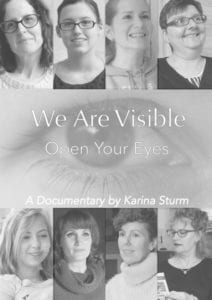‘What you can’t see can’t hurt you.’
It’s a classic and well-intentioned phrase, but we know it to be quite untrue; especially if you ask any one of the millions of people in this country that are living with a rare, ‘invisible’ disease.
Whether it’s scleroderma, cystic fibrosis, multiple sclerosis, or more — people living with an invisible disease often feel the extra pressure of explaining how/why/when they are sick, just because their symptoms are not as visible or apparent as those with other diseases.
It’s easy for many of them to feel ‘invisible’ — which is why Karina Sturm felt it was time to address that; and hopefully change it.
German born and now living in San Francisco, California — Karina produced and directed the documentary ‘We Are Visible’ which documents her journey and the journeys of others living with Ehlers-Danlos syndrome (EDS).
I had the pleasure of watching it in a crowded auditorium in Chapman University in Southern California just last month, featuring an introduction and Q&A session with Karina herself.
But before I get into that..
WHAT IS EHLERS-DANLOS SYNDROME?
Ehlers-Danlos syndrome (EDS) is a group of inherited disorders of the body’s connective tissue. These disorders affect the supportive connective tissue of the skin, bones, blood vessels as well as many organs and body tissues. There are different types of EDS which are defined by their symptoms. Most commonly, the symptoms of EDS affect the skin and joints. It is estimated that 1 in 2,500 to 5,000 people have EDS worldwide.
To learn more about EDS, click here.
And if Karina sounds familiar to you, she’s contributed to Patient Worthy before!
‘FAKER’
Before the movie was screened, Karina set the tone and theme of ‘We are Visible’ with a story that gets to the heart of the struggle with invisible diseases.
While she was excited to fulfill a childhood dream of going to Disney just the day before this screening event, her enthusiasm was tempered with a reality that has played out in her life many times, living with EDS.
I knew I needed to use a wheelchair [at Disneyland]… I am not afraid of using a wheelchair itself. In fact, I know how incredibly helpful mobility tools are for me and others. I believe using one regularly would give me more independence and prevent me from severe amounts of pain and bed rest. But I am not using one yet.
And the reason for this is how I have been treated by the people around me whenever I used a wheelchair in the past. I can hardly recall how many times people would whisper the words ”faker” when I would use a wheelchair at the airport, but then get up to walk the remaining short distance to the plane or a restroom.
WE ARE VISIBLE
According to Karina-
I was tired of being belittled and doubted by the people around me and felt invisible as a person. Then I started studying journalism and when I learned we could make a documentary for our MA thesis, I immediately knew that I wanted to produce a film about an invisible condition, specifically Ehlers-Danlos syndrome.


LABOR OF LOVE
For Karina, the experience of producing a multi-national project was physically grueling — especially on her.
The biggest struggles were the pain, exhaustion and my chronic GI issues that get worse with physical strain. I basically survived on pain meds and Gatorade because I was unable to eat anything during most times when I filmed.
One time, I was unable to walk or stand, so I would sit on an office chair and wheel around the living room of the family I was filming. Another time, I shot all sequences from one position in the room, because I couldn’t get up.
WHAT HAPPENS NOW?

I also very much hope that people understand more about invisible disabilities and stop judging people based on their appearance.


